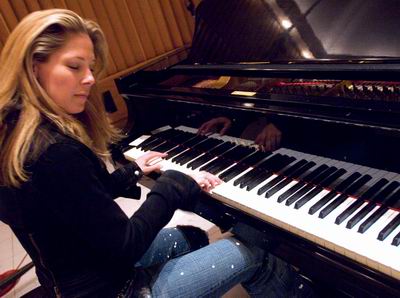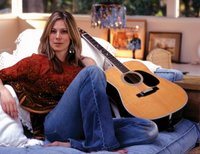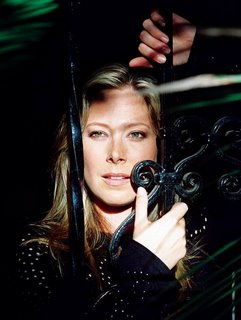 Lived-in. That’s how Alice Peacock’s new album feels. “When we were recording the strings, one of the musicians said to me, ‘This record feels like an old shirt – familiar and comfortable,’” she says.
Lived-in. That’s how Alice Peacock’s new album feels. “When we were recording the strings, one of the musicians said to me, ‘This record feels like an old shirt – familiar and comfortable,’” she says. Alice was deeply touched by the remark. In fact, she and producer Andrew Williams were striving to make a classic-sounding record. Warm as faded flannel, Who I Am recalls the golden age of singer-songwriter pop (the album’s cover was even shot by legendary rock photographer Henry Diltz). It is impeccably crafted, but what’s most affecting is how easy and organic it feels, how directly Alice’s voice connects with the listener.
Alice was deeply touched by the remark. In fact, she and producer Andrew Williams were striving to make a classic-sounding record. Warm as faded flannel, Who I Am recalls the golden age of singer-songwriter pop (the album’s cover was even shot by legendary rock photographer Henry Diltz). It is impeccably crafted, but what’s most affecting is how easy and organic it feels, how directly Alice’s voice connects with the listener.“We cut all the songs live. All my vocal performances are live,” she says, explaining how she sat at the piano singing and playing along with the band as the tape rolled. “We didn’t rehearse. Andrew just said, ‘I like to save it for the record.’” This certainly kept the studio bill manageable – Who I Am was recorded in about two weeks, at Hollywood’s Sound Factory – but more importantly, it captured an immediacy, created an intimacy, that would have been impossible if Alice had been “hands-free in front of the mic,” as she puts it. “I had to keep it simple and accept that it wasn’t going to be perfect. There’s an authenticity to the performances that people have really responded to.”
Moreover, the record unfolds naturally because it was sequenced according to how the songs best flowed into one another musically. Nevertheless, Alice says, “When we listened to it all the way through, we realized it takes you on an emotional journey. It starts out kind of dark, but by the end, it’s really affirming. It’s not just a collection of songs; listening to this record is a genuine album experience – there’s a thread that binds these songs together.”
Though some of the material can be interpreted as traditional love songs, Alice is quick to iterate that the aforementioned thread is both more expansive and more basic. It’s the very DNA of life experience: relationships. Relationships with lovers, yes, but also with friends and family and God and the universe and ourselves.
Alice confides that the album’s title track speaks to that last one: “‘Who I Am’ is very much a song to myself. I wrote it during a difficult time, when I was having doubts about the direction I was going in. I was at a point in my career where I didn’t feel particularly understood or appreciated. I did some soul-searching and realized, “I know who I am. I don’t need anyone’s approval. I’m going to be okay.’” It was at this point that she packed up and said, “I’m going to go make my own record.” Thus the lyric, “In the ways of life and art, I trust the wisdom of my heart.” She’s happy to say of the results: “This record truly expresses who I am as an artist. When I listen to it now, I can’t help saying to myself, ‘You tell ’em, sister!’”
Going it alone was something she knew she could do. After all, her first two records, 1999’s Real Day and 2002’s Alice Peacock, were both recorded independently. “There was no one looking over my shoulder when I made this record,” she points out. “I made the record I wanted to make – how many artists can say that?”
There’s a through-line there as well, stretching back to the summers Alice spent as part of a theater group. “I met all these artists, troubadours who played guitar and mandolin,” she remembers. “Some of them were making their own CDs. I didn’t know you could make your own record – that was a whole new concept for me. I look back at that now and realize it was a turning point. I started playing guitar and writing seriously. I wanted to say my own words, which I couldn’t do in theater. I wanted to see what I had to say.” She is still grateful for her theater training, however, crediting it with enabling her to give a poised performance of the National Anthem for 48,000 people at a 2005 White Sox playoff game in Chicago, which she’s called home for many years.
 Alice’s original hometown is White Bear Lake, Minn., where she grew up swimming in the lake, manning her paper route and daring her friends to stand near the Indian burial ground next door. She was also an avid reader. “We didn’t have a TV,” she informs, “because my mother was convinced it would turn our brains to JELL-O, so I devoured books. I practically lived at the library. I never really traveled when I was a kid, but I could travel in books. Books allowed me to dream. I think that’s partly why I became a writer.”
Alice’s original hometown is White Bear Lake, Minn., where she grew up swimming in the lake, manning her paper route and daring her friends to stand near the Indian burial ground next door. She was also an avid reader. “We didn’t have a TV,” she informs, “because my mother was convinced it would turn our brains to JELL-O, so I devoured books. I practically lived at the library. I never really traveled when I was a kid, but I could travel in books. Books allowed me to dream. I think that’s partly why I became a writer.”It’s also why she started the not-for-profit organization Rock for Reading, which, Alice says simply, “puts books in kids’ hands.” “To me, literacy is a basic human right, but one out of five Americans is functionally illiterate,” she reports. “Rock for Reading raised nearly $100,000 this year for literacy and reading programs in Chicago [largely though benefit concerts featuring such high-profile performers as Lucinda Williams, Nickel Creek and Steve Winwood]. Some of the bravest people I know are adults who’ve admitted they can’t read and are now learning how.”
Reading began stoking Alice’s creativity about the same time the family piano did. “I was a curious kid,” she says, “and we had a piano in the house, so I figured out how to play it. I made up songs, little melodies.” She admits that her early compositions were a way to get her parents’ attention, no small feat in a family of six children. Genetic predisposition, too, likely played a role; Alice’s maternal grandmother was a German cabaret composer and performer (her maternal grandfather was an actor, a member of Bertolt Brecht’s Berliner Ensemble).
But as Alice grew older, she found in music an emotional refuge: “I would lay on the bed in my room listening to the radio or my older sister’s records. The Beatles, Joni Mitchell, James Taylor, Carole King, Carly Simon, Tom Waits – I would listen to their music and cry because somehow, they knew exactly what I was feeling. They made me feel like I was not alone.”
She also found a masters class in that music. “I learned how to write songs through osmosis,” she explains. “I learned about chord progressions and song structure from listening. The way I write today is just what sounds right to me.”
“Becoming a songwriter was a matter of necessity,” she continues. “It’s how I communicate. It’s how I give what I have to give. It’s just what I do – if I weren’t making records and playing shows, I’d be home singing to my cats.”
It’s not surprising, then, that by the time Alice and her band finished touring in support of Alice Peacock, new songs were already making their presence known. “At least by the time we played Manila,” she estimates, where the song “Bliss” had become a #1 hit. She concedes that her visit to the Philippines was occasionally like the film “Lost in Translation,” but singing “Pink Houses” onstage at the Hoosier Dome with John Mellencamp, with whom she toured the Midwest, also bore a hint of the surreal. (Playing theaters with another gifted singer-songwriter, Aimee Mann, was perhaps more in line with Alice’s initial vision of her Alice Peacock road trajectory.)
Once back in Chicago, Alice received a call from her music publisher, who thought she might enjoy collaborating with a songwriter named Andrew Williams. Their rapport was so satisfying that after they wrote “Here I Go Again” together, Alice asked Andrew to produce Who I Am. (He’s also produced records for Victoria Williams, Peter Case and Dog’s Eye View and received acclaim for his work with his twin brother, David, in the Williams Brothers, perhaps best know for the gorgeous “Can’t Cry Hard Enough.”)
“I had enough songs for three completely different records,” she informs. “I’d done a lot of writing on my own, and I’d worked with a handful of co-writers – I love co-writing because it allows you to open a door you might not ordinarily open. I played ‘Time’ for Andrew, and he said, ‘That’s the record I want you to make. That song really makes me feel.’ We agreed that it wasn’t enough for a song to have killer hooks – it had to create an emotional bond.”
Williams’ input was also invaluable in assembling the Who I Am band: guitarist Danny Howes (Alice Peacock, Tender Idols), bassist/engineer/mixer Curt Schneider (of Five for Fighting) and drummer Jay Bellerose (Suzanne Vega, Paula Cole, Sam Phillips); Williams played acoustic guitar. “Andrew assembled the right cast and then was a great director,” Alice declares.
During one discussion of how Who I Am should sound, she asked Williams what he wanted to hear on the record, to which he responded: “12 string players.” Though they didn’t necessarily have a 12-string-players budget, Williams found musicians who Alice says “really understood the music” and were able to work with them to keep costs down. Moreover, Williams oversaw the string arrangements. “We worked on them together,” she illuminates, “though Andrew really guided the process. He’d learned a lot from working with [celebrated arranger] Paul Buckmaster, but he also has a very intuitive, finely calibrated understanding of how strings enhance the emotional impact of a song.”
Who I Am’s violins, violas and cellos (and French horn, which Williams also arranged) are key to the album’s uncanny ability to unerringly and consistently hit the brain’s pleasure center. Alice recollects the day they were recorded, at the renowned Capitol Studios: “When they put down the strings for ‘Time,’ I sat on the couch in front of the observation window and just wept – I was completely overcome. I said to myself, ‘Remember this moment because you’re never going to have another first like this.’”
 Still, the record’s chief asset is Alice’s performance, a model of restraint. She does not indulge in the kind of vocal gymnastics that have made so many pop divas indistinguishable from one another. Her human-scale singing draws the listener closer, provides communion, fosters the feeling that we are not alone.
Still, the record’s chief asset is Alice’s performance, a model of restraint. She does not indulge in the kind of vocal gymnastics that have made so many pop divas indistinguishable from one another. Her human-scale singing draws the listener closer, provides communion, fosters the feeling that we are not alone.“There’s a jewelry designer in Chicago who sent me a beautiful necklace one day and told me that my music had inspired him to give up his career as an investment banker to pursue his real passion,” Alice reveals. “Another time, a woman approached me to say my songs had helped her mother get through chemotherapy. When I hear things like that, I feel extremely honored and privileged. It’s a gift I don’t completely understand. I just know I have to stay honest and keep putting myself out there because connecting with people that way is why I became an artist.”
For more, check her Official Website.


No comments:
Post a Comment